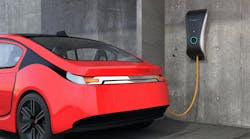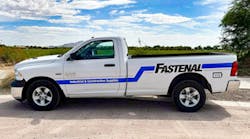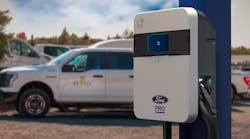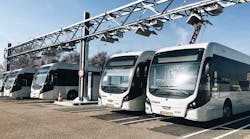The development of the electric vehicle supply equipment (EVSE) market may be one of the most interesting changes going on in the electrical products channel right now. Its potential is significant. But we're still looking at a market where the installations are done on speculation, trusting that a market will develop. At least now we have the perspective of the first year of large-scale electric car sales into the consumer market. What's different so far?
Sales of electric vehicles have lagged the automotive industry forecasts on which EVSE manufacturers and suppliers based their calculus. Even before late November, the industry was reporting much lower sales volumes on their new electric cars than their initial production plans anticipated.
On Nov. 25, the National Highway Traffic Safety Administration issued a report that the Chevrolet Volt had caught fire following crash tests in NHTSA labs. GM has fired up its damage-control machinery, pointing out that no such fires have ever been reported in the real world. Despite GM's reassurances, it seems logical that some interested buyers may wait for further confirmation that it's not a serious risk. (Given that conventional internal-combustion-driven vehicles have always involved some risk of fires and explosions, and that faulty lithium-ion batteries have already been known to cause fires in electronic devices, the Volt fires may not be as surprising to potential buyers as the initial media response suggests.)
Well before the concerns about battery fires were raised, though, many potential buyers had decided to wait for other reasons. The premium cost, even after rebates, tax breaks and other incentives, is part of the problem. A study by consulting firm Deloitte released earlier this fall found that more than half of the people surveyed worldwide said they would consider an electric car, but less than 10 percent of them said they would be willing to pay a $2,000 premium for one. Then there's the hassle of adapting to an entirely different fueling regimen where topping off the “tank” can take half a day, plus worries about being stuck in traffic with a fading battery far from a charging station. Further questions about resale value and the pace of obsolescence as vehicle and battery technologies advance may cause further pause.
The concerns over range anxiety have been a key driver of sales of EV charging systems to date. Cities and towns and utilities and private companies have led the effort to build out a charging infrastructure, but even in areas thick with early adopters, the private sector by and large is waiting to see actual demand.
North Coast Electric Co. has locations in several of the early-introduction markets and in August unveiled a solar-powered Level 2 charging station at its headquarters in south Seattle. Mark Greene, director of business development for North Coast, describes a chicken-and-egg puzzle confronting private companies.
“Once we see an influx of cars, people in the private sector will start installing charging systems, but there won't be a lot of cars until the public sector spends enough on infrastructure for them to get around functionally. Then we'll see the private sector follow,” Greene said. “A lot of people who own shopping centers, restaurants and such are interested, but they're reluctant to spend money until they know what the payback will be.”
Distributors Making The Market
Despite the setbacks, there is a lot of interest in EVSE, though actual sales of the systems haven't gained much momentum yet. The electrical distributors who have jumped into this market in a big way say it's been a little wobbly in the early going, though the wobbles were by no means unexpected.
Crescent Electric Supply, East Dubuque, Ill., announced a plan in September to install electric vehicle charging systems at 10 of its locations, starting with its branch in Rockdale, Ill. The process began with several months of research and analysis to see where the opportunities lay, says Bob Settle, Crescent's vice president of marketing. “We went through a process over several months where we mapped out where the hot spots would be for early adoption — where the vehicles were being launched. … We looked at cities that fit these criteria, then overlaid our map to see where there were market opportunities. We identified 10 cities that are key markets for us in this area and worked with our suppliers to provide chargers to at least one location in each of these cities.”
The number of customers pulling up to the Leviton Level 2 charging station has been small, but that was expected, Settle said. The company uses the systems for demonstration purposes as well as training. Settle says most of the early interest in EVSE has come from municipalities, and overall demand hasn't yet matched expectations.
“We've done a lot of research on trying to reconcile the early estimates with what's really happening. A year ago, when Obama was making a push for electric vehicles, he said there would be a million electric vehicles on U.S. roads by 2015. Clearly that's not going to happen,” said Settle. “Growth will be slow through 2012 and probably mid-2013 before there's enough vehicles in the market place that you really start seeing the infrastructure build-out other than the early adopters. From then on, we think we will see a very large market develop for the supply equipment.”
Any electrical distributor driving into this market will have a lot of suppliers to choose from. There are at least 35 companies making or private-labeling EVSE systems of varying kinds. A who's who of heavy hitters in the electrical equipment market already offer EV supply equipment, among them GE, Siemens, ABB, Schneider Electric, Leviton, Legrand, Cooper Industries, Eaton and Milbank. But there are also a lot of companies from outside the electrical industry, and many are not selling through distribution.
Greene of North Coast Electric expects to see some shake-out, with rounds of consolidations and failures before it's clear which brands will dominate this market.
Right now, the game for distributors is to get up the learning curve ahead of demand so they'll be ready when (and if) a surge rolls in. Greene said the buzz generated by the installation of its solar-powered charging station sparked a lot of customer interest and the company has 20 or 30 projects in some phase of the quotation, bidding and construction process.
Along the way, North Coast is learning a lot about what it takes to sell EV supply equipment, and the lessons are as often about bureaucracy as about technology.
“Part of it is, how do we put the financing packages together — with some bids we have to do a complete financial analysis — and with solar you've got to do a solar analysis too, to see if there's any sun,” Greene said. “A lot of it is government, so that requires that city councils and school boards vote on it, so funds have to be appropriated and the grants have to be applied-for. It certainly helps the client if we can find as much of that as possible. There's a lots of money available out there for these sorts of infrastructure improvements, but you've definitely got to help your customers find it.”
As a nice side-benefit, North Coast's EV4 solar charging station is part of the Energy Transfer Merchant (ETM) program that uses the vehicle batteries to store power from the grid. North Coast's first installation has already begun producing more power than the system uses, allowing the company to sell power back to the utility through a net-metering arrangement, said Greene.
North Coast and Crescent are both approaching EVSE as just one part of a larger energy play. Crescent has recently begun hiring to create a new 20-person “energy strategies” organization that will handle all aspects of sustainable energy, from solar and wind to energy-efficient lighting retrofits and variable-speed drive applications to EVSE, says Settle. This group will serve as internal specialists supporting the rest of Crescent's sales organization as well as blazing its own trail in the market.
“It's a leap of faith, but you've got to go where the opportunities are, and we think there's a lot in that area,” said Settle.
Installers Gear Up
Like the distributors, electrical contractors are starting to get their feet wet in the EVSE installations. EVSE systems are not all that complicated from an electrical engineering point of view, says John Banttari, senior estimator in the electrical pre-construction group at Egan Co., a contractor in Brooklyn Park, Minn. “They're not difficult to install. I can think of many pieces where it takes more problem-solving to put it together — it's not like transfer switches or VFDs (variable-frequency drives). It's just a 40A single-phase circuit. The complication comes when you add third-party billing, satellite, cell phone or hard-wired connections for billing to third party — that's the most complicated part, figuring out how customer wants to use it.”
Banttari does expect more challenging installations as larger fast-charge installations at service stations are built-out. “I think the Level 2 (charging systems) will become normal for the consumers to have and in certain instances with the major refueling stations they might put in Level 3 units to give the customer a fast charge and get him on his way,” he said. “That's where the big opportunities will come for electrical contractors. The power needed to drive that kind of charging equipment is not present in most fueling stations right now. They'll take 125A at 480/3-phase and a lot of them are probably running 240/single-phase. That's where I see a greater opportunity. Level 2s will be too slow for the quick fills the consumer would want if he's away from home.”
Also like the distributors, contractors are approaching EVSE as part of a larger effort. Developing expertise in EVSE technology and installation is a foot in the door for promoting Egan's full range of services, Banttari says. “In the end, the opportunity for us is when a corporate headquarters' building manager calls and says, ‘What's this EVSE all about?’ we can say, ‘Yeah we know all about them, we'd like to get out and see your campus.’ That gets you in the door. Then you can explain to him that if he installs more than a couple of these he might adversely affect his electrical distribution system — overload it in other words. So it's an opportunity for us to talk about other things we might be able to offer his company along the lines of renewable energy products, methods of energy-efficiency savings in the facilities in terms of lighting and VFDs and other things.”
The first electric cars of the current era only recently arrived in Minneapolis and the surrounding markets where Egan does its work, so there has been more interest than actual demand for EVSE installations, Banttari says. “It seems the car manufacturers have been reluctant to dive in up here in the cold Northland, like they said, ‘Let's see how they're received in a less-harsh climate first.’ The Volt has made it to all the dealers — they all have one in stock — but that's just happened in the past 30 to 60 days. The (Nissan) Leaf has yet to show up here. We haven't seen a lot of vehicles out there, and that limits our inquiries. Building owners and property managers are aware of the need for it, but they just haven't had the demand quite yet.”
Staying Flexible
Blazing a trail in a new product area requires a different business plan that accounts for the increased risk. Both Crescent and North Coast are approaching the EVSE market as part of a bigger effort to establish expertise in energy and to further solidify their reputations as market-makers instead of just order-takers.
“This is an exciting time to be in the electric supply business,” Greene of North Coast said. “It takes an electrical contractor to put these in, and ultimately contractors are going to buy these from electrical distributors. There's only a percentage of the distributors that are market-makers. With our separate business development and energy solutions groups, their whole model is to go out and make those markets or decide we're not going to be in them. You have to centralize the knowledge and train your core group, and then roll it out. There's no sense in training everyone on solar equipment when there isn't the demand. We centralize that knowledge base, and that allows us to venture into areas where a lot of distributors don't go.”
Utilities Prepare The Power
The impact of electric vehicle supply equipment (EVSE) on the electric grid has been a point of contention for some time, with some claiming that a proliferation of EV charging could cause serious trouble for power distribution systems while others predict that the potential for utilities to use car batteries as distributed energy storage could be the salvation of renewable energy and smart grid efforts.
A couple of recent reports from the Edison Electric Institute (EEI) and the Electric Power Research Institute (EPRI) offer power companies a roadmap for evaluating electric vehicles' potential impact on their service areas and promoting the adoption of electric vehicles among their customers. In The Utility Guide to Plug-In Electric Vehicle Readiness, the EEI lays out what utilities need to consider and who they need to get on-board to make the most of the opportunities presented by EVSE.
The opportunities involved are substantial, said the EEI report. “Utilities have an important role in supporting, encouraging, and enabling this technology. Moreover, the strategic value of integrating electric transportation into your overall corporate goals and objectives is substantial — from new business opportunities, to operational and system benefits, to improved customer satisfaction. Utilities should engage now to shape the future of this market and prepare for being the transportation fuel providers of the coming decades.”
EEI's paper draws on the experiences of first-adopter utilities to present a step-by-step process for getting up to speed on EVSE. It outlines recommended staffing levels; options for adding electric vans, bucket trucks and other equipment to their service fleets; recommendations on public-outreach, promotions and incentives to encourage customers to consider plug-in electric vehicles (PEVs); lists of regulators and other government officials and industry players they'll need as allies; guides and references for evaluating their local distribution grid's readiness to handle the additional loads from residential and commercial charging equipment; and preparing for future developments in the technology such as demand response or “smart” charging programs and vehicle-to-grid communication and energy storage possibilities.
Perhaps the most important issue right now for the utilities is how the addition of residential and commercial EVSE loads will affect the power grid. In Transportation Electrification: A Technology Overview, released in July, EPRI researchers took a deep look at how clusters of new EVSE installations may affect utility operations and found that the load added to electrical grids by EV charging is not likely to cause any significant problems for utilities. “Even without smart charging the load of vehicle charging is relatively well distributed,” the study said. It found that even though we can expect a surge of PEV power demand when people get home from work between 5 p.m. and 6 p.m., “In this projection, PEV demand peaks at 5 p.m. and averages to approximately 720W per plug-in vehicle due to the diversity in the aggregate load. … Overall, feeder load growth is expected to increase only slightly due to PEV adoption.”
EPRI found that on older systems the addition of EVSE loads may require upgrades. “The short-term impacts for most utilities studies should be minimal and localized. There is a possibility, however, of isolated impacts on some distribution transformers and secondary drops, particularly in neighborhoods with older distribution systems including underground systems.”
Even though it suggests that the impact on the grid is likely to be mild and manageable, EPRI advised utilities that delays in addressing problems that do arise will cause more problems, so it's better to get ahead of the curve. “EPRI believes that potential stresses on power delivery systems can be mitigated through asset management, system design practices, controlled charging of PEV, or some combination of the three. But again, given the likely variability in customers' PEV choices, car types, varied charging patterns, varied charging speed preferences, and variable participation in utility-centric TOU (time of use) charging options, we believe that the utility will not be able to manage this risk in an ex post fashion. In many cases, the utility will likely not be notified or aware of a PEV addition, or a unique charging pattern. As such, a proactive risk mitigation strategy is recommended to remove localized risk to the distribution system,” said the report.










